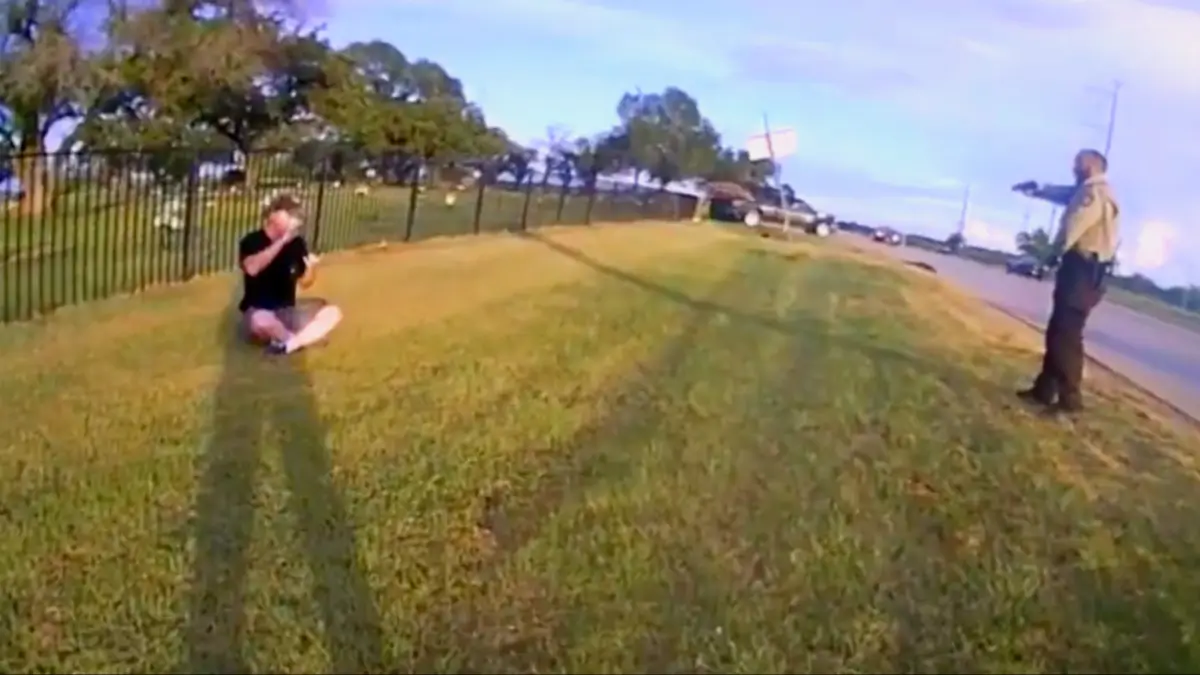Texas Man Who Gave Deputies the Middle Finger After ‘Nearly Being Ran Over’ Says He Was Arrested to be Taught a Lesson; Judge Ruled His Lawsuit Can Move Forward

A Texas man who was jogging along a highway in June of 2021 and says he gave the middle finger to a deputy sheriff who almost hit him with his patrol car contends that the officer decided to “teach him a lesson” by roughing him up, pepper-spraying him in the face and arresting him for no good reason. He has been fighting a legal battle with Guadalupe County and its sheriffs ever since.
In his federal lawsuit filed in U.S. District Court in San Antonio in 2023, Ronald Smith says he was training for a marathon as he jogged along Highway 46 near Bulverde, Texas, when the sheriff’s cruiser nearly clipped his shoulder.
After indicating his displeasure over “nearly being run over” with his obscene hand gesture, Smith says he noticed that the sheriff’s vehicle driven by Deputy Sheriff Hunter Saenz kept passing by and “circling like a shark” as he ran.
At some point he took a break on the side of road, and played a video game on his phone as he rested, his complaint says. Then he started moving again, including running across some fenced-in fields, unaware that Saenz was following him until he reached the county cemetery, when he saw Saenz approaching and pointing a firearm at him.

At the same time, Deputy Jimmy Gonzalez arrived, jumped out of his patrol car and also pointed his firearm at Smith, both men yelling for him to put up his hands and to “Get on the ground, now!”
According to body camera footage of the encounter, Smith was sitting cross-legged in the grass, with a cellphone in one hand and his other arm held up in the air. He had called 911 and was fearfully telling a dispatcher that officers were pointing their guns at him.
Saenz then directed Gonzalez not to use lethal force and said that he was going to use “less than lethal force,” and pulled out his pepper ball gun. He then shot Smith in the head, and a white substance containing a respiratory irritant spread over Smith’s face, which Smith says caused him pain, labored breathing, physical distress and high anxiety.
Smith began screaming to the 911 operator that he had been shot and that he had not done anything wrong, as the officers continued to yell at him to lie down.
When he didn’t respond to their directions, the officers approached, “roughly rolled him over, handcuffed him and swept his body for weapons, finding none,” according to Magistrate Judge Elizabeth Chestney’s factual summary written as part of her ruling to allow the case to proceed last November.
During the handcuffing, Smith screamed he could not breathe and that he was wheezing from the pepper spray’s irritants. The officers called an ambulance, but Smith refused to cooperate with the EMTs when they arrived. He was informed that he was being arrested for “evading arrest” and was taken to the hospital for medical clearance before being transported to the Guadalupe County Jail.
The charges against Smith were ultimately dismissed on August 11, 2022, about a year later.
His lawsuit originally accused Guadalupe County, Saenz and Gonzalez of using excessive force, and Saenz and the deputies’ supervisor Robert Locker (who later arrived at the scene of the arrest) with malicious prosecution. Saenz was also accused of false arrest.
The lawsuit says the county also failed to properly supervise its officers and to train them on the use of physical force, reasonable suspicion and probable cause.
Smith’s legal team argued that the officers had no probable cause to stop or arrest him for running along or sitting by the road, that they needlessly chose to use coercive force against an unarmed man who was not threatening them, and that their real underlying reason for contacting and detaining Smith was to “teach him a lesson” for “insulting law enforcement.”
The complaint says bodycam video shows that after he was cuffed, the officers were casting about for reasons to justify the arrest, first citing his need for a medical evaluation, then his alleged suspicious behavior and criminal trespassing by running through private property, before finally deciding on evading arrest after nearby property owners the sheriffs contacted expressed no interest in pressing trespassing charges against him.
“They are Monday morning quarterbacking: ‘Why do we have this guy? What can we charge him with?’” Smith’s attorney, Andy Cano, told KXAN. “They are trying to justify, retroactively, their conduct.”
Smith also claimed he had an allergic reaction to the pepper spray that by the time he got to the hospital caused him to convulse and have seizure-like symptoms, and that he briefly lost control of his bodily functions. He says those irritants continue to cause him respiratory problems, and that he also has recurring migraine headaches and symptoms of post traumatic stress disorder (PTSD) stemming from the violent encounter.
In their legal filings, attorneys for the Guadalupe County sheriffs have argued that they are entitled to qualified immunity on all of Smith’s claims, question the extent to which he was actually injured, and contend that their actions to initially detain and then charge him with evading arrest were reasonable under the circumstances.
In her ruling on the defendants’ motion for summary judgment on Nov. 5, Judge Chestney agreed that Saenz and Locker were entitled to qualified immunity on Smith’s false arrest claim, because Saenz had submitted an affidavit of probable cause to a magistrate judge, an intermediary who determined that probable cause existed to arrest Smith for “evading arrest/detention” prior to his jailing.
In his probable cause affidavit, Saenz wrote that he first saw Smith sitting in a crouched position on the shoulder of the road, “fidgeting with something in his hands.” Adding that when he came back around to speak with him, Smith jumped a physical barrier to a property (a barbed wire fence) and took off running, crossing other physical barriers and fields as Saenz pursued him while announcing that he was with the sheriff’s office and telling him to stop. He said Smith tried to hide in some brush before he ran across the highway and then sat on the ground.
“Less than lethal force was used to gain his compliance after [Smith] failed to obey lawful orders,” Saenz concluded.
Smith argues that he was not actively resisting arrest and there was no underlying crime to support an arrest in the first place.
The judge noted that Smith was charged with evading arrest, not resisting arrest. Texas law says that a person violates the law against evading arrest “if he intentionally flees from a person he knows is a peace officer … attempting lawfully to arrest or detain him.”
Smith admitted that he knew that Saenz was a law enforcement officer, and bodycam video backs up the deputy’s claim that he repeatedly told Smith to stop as he chased him, the judge observed.
Saenz’s offense report states that he believed, based on his training and experience, that Smith was trying to avoid contact with law enforcement as he had or was about “to commit a crime by trespassing on property with a clear defined physical barrier to prevent entry/exit,” and then the officer watched him do so, without the “effective consent” of the property owner.
“There is no basis for finding that Deputy Saenz should have known that his affidavit failed to establish probable cause for his belief that Smith had trespassed on private property and was fleeing from law enforcement,” Chestney found.
Chestney dismissed the claims of false arrest and malicious prosecution, but ruled that Smith’s excessive force claim against Saenz and Gonzales had merit.
Noting that “the touchstone of the Fourth Amendment is reasonableness,” Chestney wrote that prior case law has established that even when a suspect refuses to comply with instructions and physical force is justified, “officers must select the appropriate degree of force.”
A jury could readily conclude from the video evidence, she wrote, that the force used by the deputies was “‘clearly excessive’ to its need and therefore not reasonable … Saenz and Gonzalez brandished and pointed loaded firearms at Smith’s body when he was seated in a passive cross-legged position while holding one empty hand in the air and grabbing a cell phone with the other hand. In this position there was no objective reason to believe that Smith was armed … Smith was not threatening the officers … Smith was passively seated on the ground in a completely defenseless posture. … Rather than attempting to calm Smith and secure his compliance through verbal or less-invasive interventions, Saenz and Gonzales rapidly escalated the police encounter.”
Chestney also found that video evidence from Saenz’s body camera recorded at the hospital contradicted Smith’s claim that he had a severe allergic reaction to the pepper spray. Noting in her summay that “he does not display any physical or psychological distress in the video and does not complain of any injuries.” Adding that he did experience “slight nausea after drinking a bottle of water to address his dehydration from being out in the sun all day.”
She found his claims of ongoing migraine headaches and PTSD stemming from the incident more compelling, as they are backed up by medical records.
Chestney sent the case back to the U.S. District Court, where Judge Orlando L. Garcia upheld her findings, and on Nov. 21 ordered the excessive force claims against Saenz and Gonzalez to proceed to trial.
Smith is seeking a jury trial to determine compensatory and punitive damages for his physical pain, mental anguish and ongoing medical expenses, and to punish the deputies for their “outrageous conduct.” The complaint asks for a judgment of $7 million against Saenz, and $3 million against Gonzalez.
Another judge previously dismissed the claims against Guadalupe County.
In December, Saenz and Gonzalez appealed the court’s denial of their qualified immunity claim to the U.S. Fifth Circuit Court of Appeals. Discovery is ongoing in the appellate case.




